Journal Description
Foods
Foods
is an international, peer-reviewed, open access journal on food science published semimonthly online by MDPI. The Italian Society of Food Sciences (SISA) and Spanish Nutrition Foundation (FEN) are affiliated with Foods and their members receive discounts on the article processing charges.
- Open Access— free for readers, with article processing charges (APC) paid by authors or their institutions.
- High Visibility: indexed within Scopus, SCIE (Web of Science), PubMed, PMC, FSTA, AGRIS, PubAg, and other databases.
- Journal Rank: JCR - Q1 (Food Science and Technology) / CiteScore - Q1 (Health Professions (miscellaneous))
- Rapid Publication: manuscripts are peer-reviewed and a first decision is provided to authors approximately 14.5 days after submission; acceptance to publication is undertaken in 2.5 days (median values for papers published in this journal in the second half of 2024).
- Recognition of Reviewers: reviewers who provide timely, thorough peer-review reports receive vouchers entitling them to a discount on the APC of their next publication in any MDPI journal, in appreciation of the work done.
Impact Factor:
4.7 (2023);
5-Year Impact Factor:
5.1 (2023)
Latest Articles
Impacts of Various Reheating Methods on Crispy Chicken: Physicochemical Properties, Oxidation and Flavor Profiles
Foods 2025, 14(9), 1574; https://doi.org/10.3390/foods14091574 (registering DOI) - 29 Apr 2025
Abstract
In this study, the impacts of water-bath reheating (WR), steam reheating (SR), air-frying reheating (AR), roasting reheating (RR), and microwave reheating (MR) on the physicochemical properties, oxidation, and flavor profiles of crispy chicken (CC) were investigated. The results revealed that the pH of
[...] Read more.
In this study, the impacts of water-bath reheating (WR), steam reheating (SR), air-frying reheating (AR), roasting reheating (RR), and microwave reheating (MR) on the physicochemical properties, oxidation, and flavor profiles of crispy chicken (CC) were investigated. The results revealed that the pH of CC was significantly reduced after reheating (p < 0.05). The AR samples had a slight change in L* and the highest springiness. The RR samples had the highest degree of lipid and protein oxidation. In addition, WR, AR, RR, and MR treatments effectively increased the contents of umami-related amino acids. Glu and Cys were typically the taste-active amino acids in CC. AR contributed to increasing the response values of umami and richness. As shown by the electronic nose and Gas Chromatography–Mass Spectrometry (GC-MS) analysis, 41 volatile compounds were obtained in CC. AR could efficiently increase the contents of nitrogen oxides and methyl compounds. Meanwhile, the content of trans-.alpha.-bergamotene, nonanal, and copaene were significantly increased after the AR process (p < 0.05). According to the results of analysis of variance (ANOVA), odor activity value (OAV), and variable importance in projection (VIP), anethole was considered the key differential flavor-active compound. Overall, AR was superior to other reheating methods in CC, with better texture and various flavor characteristics. This study provides a reference for choosing reheating technology for pre-cooked chicken products.
Full article
(This article belongs to the Section Meat)
Open AccessArticle
Co-Fermentation and Genomic Insights into Lactic Acid Bacteria for Enhanced Propionic Acid Production Using a Non-GMO Approach
by
Lidia Stasiak-Różańska, Jan Gawor, Kamil Piwowarek, Agata Fabiszewska and Tamara Aleksandrzak-Piekarczyk
Foods 2025, 14(9), 1573; https://doi.org/10.3390/foods14091573 (registering DOI) - 29 Apr 2025
Abstract
Propionic acid (PA) is an important organic acid with applications in food preservation, feed additives, and bio-based chemical production. While industrial PA is mostly derived from petrochemical processes, sustainable microbial alternatives are gaining attention. In this study, we explored a co-fermentation strategy using
[...] Read more.
Propionic acid (PA) is an important organic acid with applications in food preservation, feed additives, and bio-based chemical production. While industrial PA is mostly derived from petrochemical processes, sustainable microbial alternatives are gaining attention. In this study, we explored a co-fermentation strategy using lactic acid bacteria (LAB) with complementary metabolic capabilities to enhance PA biosynthesis via the 1,2-propanediol (PDO) pathway. Genome-based screening identified a metabolic division between strains capable of producing PDO (e.g., Carnobacterium maltaromaticum IBB3447) and those converting PDO to PA (e.g., Levilactobacillus brevis IBB3735). Notably, we discovered that C. maltaromaticum IBB3447 is capable of PDO 24 biosynthesis, a function previously undescribed in this species. Phenotypic assays confirmed glycerol metabolism and acid tolerance among strains. In co-culture fermentation trials, the highest PA concentration (6.87 mM) was achieved using simultaneous fermentation in a fructose–sorbitol–glucose (FRC-SOR-GLC) medium, accompanied by prior PDO accumulation (up to 13.13 mM). No single strain produced PA independently, confirming that metabolic cooperation is required. These findings reveal a novel LAB-based bioprocess for sustainable PA and PDO production, using cross-feeding interactions and the valorization of industrial waste streams. The study supports future optimization and scale-up for circular bioeconomy applications.
Full article
(This article belongs to the Special Issue Application of Fermentation Biotechnology in Food Science)
Open AccessArticle
Modified Test Kit for Detecting Polar Compounds and Evaluating Their Distribution in Reused Frying Oil
by
Rapeepan Yongyod and Anusak Kedsin
Foods 2025, 14(9), 1572; https://doi.org/10.3390/foods14091572 (registering DOI) - 29 Apr 2025
Abstract
Polar compounds in repeatedly used frying oil pose significant health risks to consumers. This study aimed to develop an improved test kit for detecting polar compounds in used frying oils and to compare the distribution of polar compounds across different types of cooking
[...] Read more.
Polar compounds in repeatedly used frying oil pose significant health risks to consumers. This study aimed to develop an improved test kit for detecting polar compounds in used frying oils and to compare the distribution of polar compounds across different types of cooking oils. The modified test kit was evaluated using six types of oils, which were heated and tested against a standard method with 100 samples. The modified test kit demonstrated an accuracy of 92.00%, sensitivity of 88.09%, specificity of 94.82%, positive predictive value of 92.50%, and negative predictive value of 91.66%. The polar compound distribution was analyzed in six types of oils: palm oil, coconut oil, rice bran oil, sunflower oil, canola oil, and soybean oil. Coconut oil was found to be the least suitable for frying due to the rapid formation of polar compounds. In contrast, rice bran oil, sunflower oil, canola oil, and palm oil were more suitable for frying, with polar compound contamination occurring only after more than 80 h of use. These findings can assist food service operators in extending oil usage while ensuring consumer safety.
Full article
(This article belongs to the Section Food Analytical Methods)
Open AccessArticle
Production and Evaluation of Kleija-like Biscuits Formulated with Sprouted Mung Beans
by
Hassan Barakat, Raghad M. Alhomaid and Raya Algonaiman
Foods 2025, 14(9), 1571; https://doi.org/10.3390/foods14091571 (registering DOI) - 29 Apr 2025
Abstract
Recently, significant interest has been shown in developing enhanced, nutrient-dense snacks. This study aimed to develop a Kleija-like biscuit, a traditional Saudi Arabian product, enhanced with sprouted mung bean flour (SMBF) to improve its nutritional profile while maintaining key sensory characteristics. The biscuits
[...] Read more.
Recently, significant interest has been shown in developing enhanced, nutrient-dense snacks. This study aimed to develop a Kleija-like biscuit, a traditional Saudi Arabian product, enhanced with sprouted mung bean flour (SMBF) to improve its nutritional profile while maintaining key sensory characteristics. The biscuits were formulated by partially replacing wheat flour with varying proportions of SMBF (10–40%), followed by a comprehensive evaluation of the biscuits’ characteristics. The results showed a significant increase in protein content, with marked enhancement in the amino acid profile. Essential amino acids, such as lysine and histidine, attained a biological value estimated at approximately 55%. Additionally, the essential amino acid index for samples containing 30–40% SMBF was reported to be around 60%. Furthermore, enhanced levels of phenolic acids and flavonoids were observed in biscuits with high SMBF content, with total flavonoids and carotenoids rising over 50%. Consequently, antioxidant activity improved markedly, with increases ranging from 20% to 45%. Furthermore, the glycemic response of these biscuits demonstrated a notable reduction. Sensory evaluations indicated high consumer acceptance, particularly in taste, texture, and overall appeal. However, the inclusion of 40% SMBF resulted in lower acceptance, suggesting that while higher SMBF levels enhance the nutritional profile, they may adversely affect sensory qualities if not balanced. Future research should focus on optimizing SMBF levels and investigating ingredient combinations to enhance flavor while satisfying consumer health and taste preferences for commercial scalability. In conclusion, incorporating SMBF into biscuit production presents significant potential for developing nutrient-dense snacks for individuals combating obesity and associated chronic diseases.
Full article
(This article belongs to the Special Issue Traditional and Non-Traditional Grain-Based Products: Addressing Challenges Through Formulation and Processing)
Open AccessArticle
Preparation of Epigallocatechin Gallate-Enriched Antioxidant Edible Films Based on Konjac Glucomannan and Sodium Alginate: Impact on Storage Stability of Mandarin Fish
by
Ran Wang, Yuqi Wang, Xinzhen Zhang, Yang Gao, Xian Wu, Xueling Li, Zhengquan Liu, Yue Sun and Jin Liang
Foods 2025, 14(9), 1570; https://doi.org/10.3390/foods14091570 (registering DOI) - 29 Apr 2025
Abstract
The objective of this research was to prepare robust edible films possessing antioxidant properties by utilizing konjac glucomannan (KGM), sodium alginate (SA), and epigallocatechin gallate (EGCG). This research also involved structural characterization and the assessment of functional attributes of the composite films with
[...] Read more.
The objective of this research was to prepare robust edible films possessing antioxidant properties by utilizing konjac glucomannan (KGM), sodium alginate (SA), and epigallocatechin gallate (EGCG). This research also involved structural characterization and the assessment of functional attributes of the composite films with varying EGCG concentrations. It was found that the inclusion of EGCG reduced the viscosity of the edible film solutions while enhancing their mechanical strength. Fourier transform infrared spectroscopy demonstrated adequate compatibility among the film-forming materials, with EGCG forming hydrogen bond interactions with KGM and SA. SEM analysis revealed that increasing EGCG concentration led to the formation of discontinuous blocks and rough surfaces, with smooth and fine-grained particles observed at 0.2% (w/v) EGCG concentration. Furthermore, results from the application of the KGM-SA-based films in chilled mandarin fish showed that they could exert antioxidant function when incorporated with EGCG. The values of TVB-N and TBARS of fish pieces were obviously decreased in the 12-day storage period, indicating their potential to increase the shelf life of freshwater fish food.
Full article
(This article belongs to the Section Foods of Marine Origin)
Open AccessArticle
Genomic Characterization and Functional Evaluation of Eurotium cristatum EC-520: Impacts on Colon Barrier Integrity, Gut Microbiota, and Metabolite Profile in Rats
by
Huini Wu, Xiuping Wang, Xiangrui Kong, Ruiyang Shan, Song Peng, Mengshi Zhao, Changsong Chen, Wenquan Yu and Zhaolong Li
Foods 2025, 14(9), 1569; https://doi.org/10.3390/foods14091569 (registering DOI) - 29 Apr 2025
Abstract
Eurotium cristatum (EC), the dominant fungus in Fuzhuan brick tea, has significant applications in food fermentation and pharmaceutical industries, exhibiting probiotic properties, but further investigation of its intestinal benefits is required. This study characterized the EC-520 strain through whole genome sequencing and evaluated
[...] Read more.
Eurotium cristatum (EC), the dominant fungus in Fuzhuan brick tea, has significant applications in food fermentation and pharmaceutical industries, exhibiting probiotic properties, but further investigation of its intestinal benefits is required. This study characterized the EC-520 strain through whole genome sequencing and evaluated its effects on rat colons using histomorphology, 16S rRNA sequencing, and untargeted metabolomics. The genomic analysis revealed that EC-520 possessed a 28.37 Mb genome distantly related to Aspergillus flavus. The 16S results demonstrated that EC-520 significantly increased the abundance of Bacteroidota (p < 0.05) while decreasing the Proteobacteria and Firmicutes/Bacteroidota ratio (the F/B ratio); at the genus level, it elevated Muribaculaceae and Clostridia_UCG-014 while reducing harmful bacteria. The metabolomic results showed that EC-520 also significantly altered tryptamine, caproic acid, isocaproic acid, and erucic acid (p < 0.05). Additionally, the Spearman’s correlation analysis revealed that Muribaculaceae_unclassified and Clostridia_UCG-014_unclassified were significantly positively correlated with tryptamine, caproic acid, isocaproic acid, and erucic acid. Therefore, this study suggested that EC-520 enhanced the colon barrier and increased the abundance of Muribaculaceae_unclassified and Clostridia_UCG-014_unclassified, thus promoting the secretion of tryptamine and affecting the release of 5-hydroxytryptamine (5-HT). It also promoted the secretion of certain fatty acids, enhancing the balance of the colonic microbiota. This study provides a new view for a comprehensive understanding of EC’s regulatory role in the colon.
Full article
(This article belongs to the Section Food Microbiology)
►▼
Show Figures
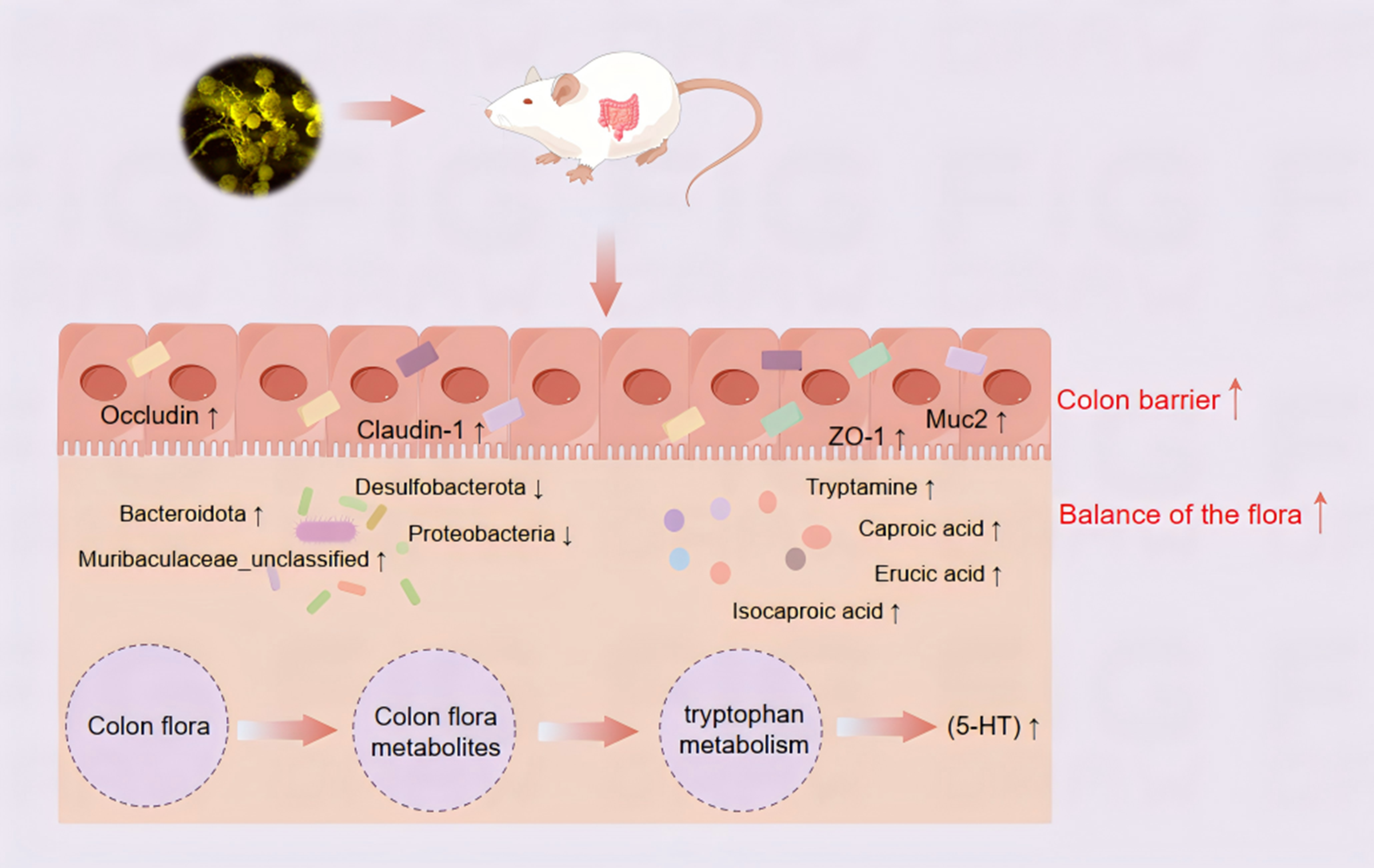
Graphical abstract
Open AccessArticle
Prickly Pear and Pomegranate Peel Extracts as Natural Antioxidants: Effects on Colour, Lipid, and Protein Oxidation in Refrigerated Cooked Chicken Models
by
Guadalupe Lavado and Ramón Cava
Foods 2025, 14(9), 1568; https://doi.org/10.3390/foods14091568 - 29 Apr 2025
Abstract
This study investigates the antioxidative potential of pomegranate peel extract (PPE) and prickly pear peel extract (HPE) as natural preservatives in cooked chicken models. The extracts were characterized for their phenolic and tannin content, and their antioxidant activity was measured through in vitro
[...] Read more.
This study investigates the antioxidative potential of pomegranate peel extract (PPE) and prickly pear peel extract (HPE) as natural preservatives in cooked chicken models. The extracts were characterized for their phenolic and tannin content, and their antioxidant activity was measured through in vitro chemical assays using ABTS, DPPH, and FRAP assays. Cooked chicken samples were formulated with different concentrations of PPE or HPE and compared to sodium nitrite (NaNO2) treatment. The effects on lipid and protein oxidation, instrumental colour parameters, and aldehyde formation were evaluated during storage. The results demonstrated that PPE exhibited higher antioxidant activity compared to HPE, particularly at higher concentrations. PPE_300 had the highest phenolic content, exhibited the strongest radical scavenging activity, and significantly reduced lipid oxidation markers such as malondialdehyde and lipid hydroperoxides. PPE also preserved protein integrity by reducing carbonyl formation and maintaining thiol levels. Colour stability was improved in both PPE- and HPE-treated samples, although nitrite remained the most effective in maintaining redness (a*-values). These findings suggest that PPE, particularly at 300 mg/kg, is a promising natural alternative to synthetic antioxidants for improving oxidative stability and shelf life in meat products. Further research should explore sensory attributes and consumer acceptance to facilitate industrial applications.
Full article
(This article belongs to the Section Meat)
Open AccessArticle
Extraction of Bound Polyphenols from Elaeagnus angustifolia L. by Ultrasonic-Assisted Enzymatic Hydrolysis and Evaluation of Its Antioxidant Activity In Vitro
by
Jingjing Lv, Lu Li, Zilong Liang, Wenyue Wu, Na Zhang and Qinghua Jia
Foods 2025, 14(9), 1567; https://doi.org/10.3390/foods14091567 - 29 Apr 2025
Abstract
Herein, Elaeagnus angustifolia L. was utilized as a raw material to extract bound polyphenols using an ultrasound-assisted complex enzyme method for the first time. The effects of enzyme ratio, ultrasonic time, liquid-to-solid ratio, and pH value on the bound polyphenol yield were investigated
[...] Read more.
Herein, Elaeagnus angustifolia L. was utilized as a raw material to extract bound polyphenols using an ultrasound-assisted complex enzyme method for the first time. The effects of enzyme ratio, ultrasonic time, liquid-to-solid ratio, and pH value on the bound polyphenol yield were investigated using single-factor experiments. The key parameters were subsequently optimized using the Box–Behnken design. The optimal conditions identified were as follows: enzyme ratio (α-amylase/cellulase = 5:1 mg/mg), ultrasonic time of 50 min, liquid-to-solid ratio of 12:1 mL/g, and pH value of 5. Under these conditions, the bound polyphenol yield was measured at 13.970 ± 0.3 mg/g. A total of 27 phenolic compounds were identified using ultrahigh-performance liquid chromatography–ion mobility quadrupole time-of-flight mass spectrometry (UPLC–IMS-QTOF-MS), including two coumarins, five lignins, 10 polyphenols, nine flavonoids, and one tannin, and specifically containing Angeloylgomisin Q, Yakuchinone A, Furosin, 6-Dehydrogingerdione, and 4′-Methylpinosylvin, and so on. Antioxidant activity was assessed using the 1,1-diphenyl-2-picryl-hydrazil (DPPH) and 2,2′-azino-bis-(3-ethylbenzthiazoline-6-sulfonate) (ABTS) methods, revealing significant antioxidant potential. This study introduced a novel extraction process for bound polyphenols from E. angustifolia L. and provided the first qualitative analysis of bound polyphenols in this species, establishing a scientific foundation for its development and application in the functional food, medicine, and cosmetics industries.
Full article
(This article belongs to the Section Food Nutrition)
►▼
Show Figures

Figure 1
Open AccessArticle
Ripening-Associated Changes in Fatty Acid Composition and Nutritional Indices in Caciocavallo Silano PDO Cheese
by
Giuseppe Tardiolo, Eleonora Di Salvo, Simona Tringali, Giovanni Bartolomeo, Claudia Genovese, Maria Elena Furfaro, Anna Maria Sutera, Antonino Nazareno Virga, Nicola Cicero and Alessandro Zumbo
Foods 2025, 14(9), 1566; https://doi.org/10.3390/foods14091566 (registering DOI) - 29 Apr 2025
Abstract
Caciocavallo Silano PDO is a traditional Italian stretched-curd cheese produced in southern Italy, subjected to a minimum ripening period of 30 days. The present study aimed to characterize the chemical composition and fatty acid (FA) profile at three ripening stages (up to 120
[...] Read more.
Caciocavallo Silano PDO is a traditional Italian stretched-curd cheese produced in southern Italy, subjected to a minimum ripening period of 30 days. The present study aimed to characterize the chemical composition and fatty acid (FA) profile at three ripening stages (up to 120 days). The proximate composition, FAs profile, and lactose content of cheese samples from three production batches, all made with Friesian cow milk, were analyzed. The results showed significant compositional changes during maturation. Moisture content decreased from 46.5% in 30 days to 33.0% in 120 days, with a corresponding increase in protein and fat content. Lactose content was below the limit of quantification (LOQ) at all ripening stages, confirming its natural depletion over time. The FA analysis revealed thirty-five different FAs, including fourteen saturated fatty acids (SFAs), nine monounsaturated fatty acids (MUFAs), and twelve polyunsaturated fatty acids (PUFAs). Among SFAs, palmitic and stearic acids were the most abundant, while lauric and myristic acids significantly increased with ripening. The sum of MUFAs showed a slight decrease, mainly due to the reduction in oleic acid, which dropped from 22.6% to 21.3% over maturation. Conversely, PUFAs exhibited a significant increase, particularly linoleic and α-linolenic acids, which are associated with positive health effects. In particular, an increase in PUFA composition and an optimal omega-6/omega-3 ratio could have a positive effect on health, with a consequent enhancement of cardiovascular function. The findings suggest that cheese maturation influences its nutritional and lipid profile, with potential implications for consumer health. Future research should assess how feeding strategies and production methods impact the FA composition of Caciocavallo Silano PDO.
Full article
(This article belongs to the Section Food Physics and (Bio)Chemistry)
►▼
Show Figures
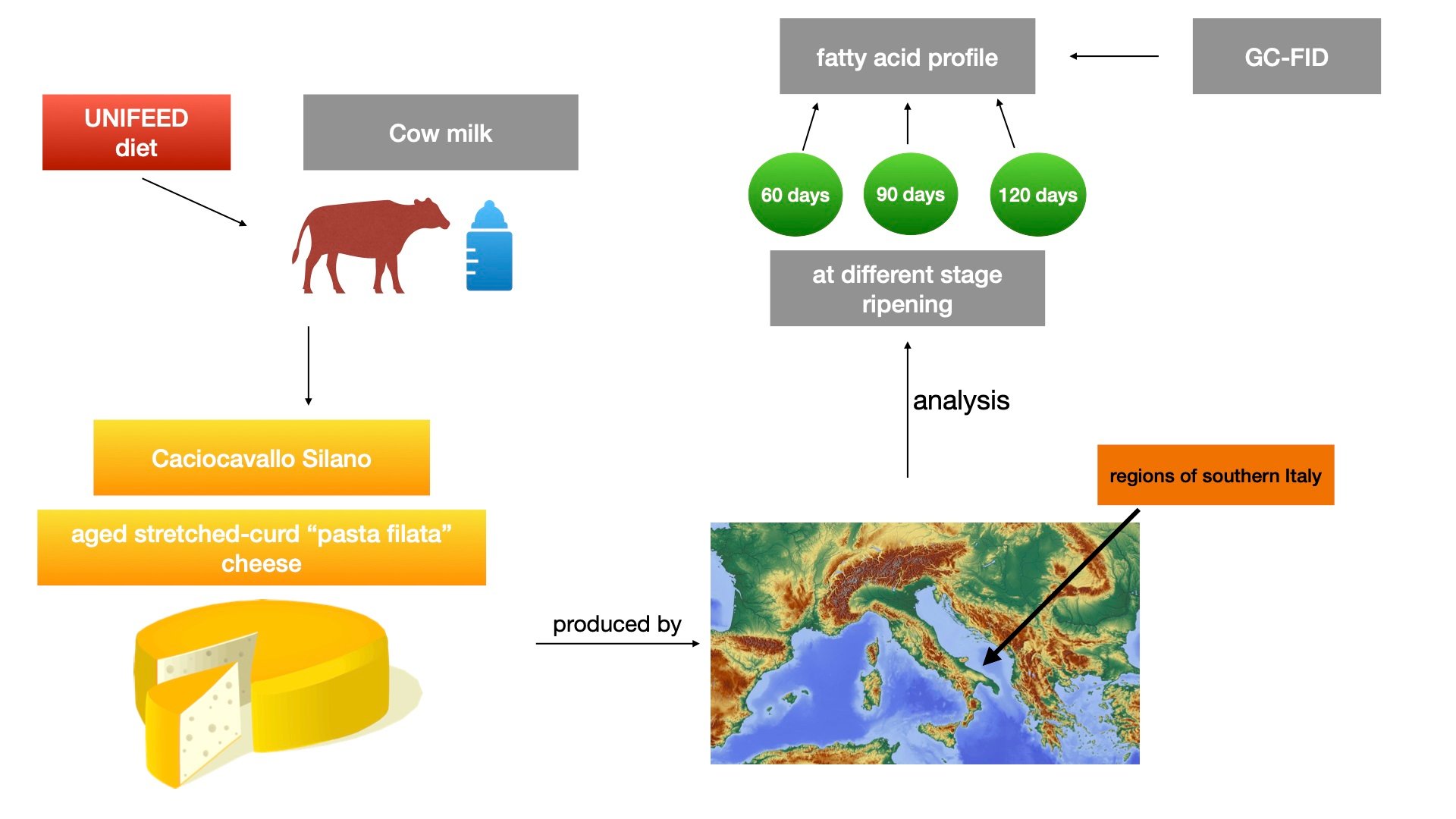
Graphical abstract
Open AccessArticle
Grape Pomace Fibres as a Sustainable Fining Agent to Ensure Red Wine Safety: A First Approach in a Continuous System
by
Lucía Osete-Alcaraz, Encarna Gómez-Plaza, José Oliva-Ortiz, Miguel Ángel Cámara, Bodil Jørgensen, Ricardo Jurado-Fuentes and Ana Belén Bautista-Ortín
Foods 2025, 14(9), 1565; https://doi.org/10.3390/foods14091565 - 29 Apr 2025
Abstract
Grape pomace is the largest by-product in the oenological industry, and in recent years, there have been multiple attempts to turn it into a high-value product, such as a fining agent. However, most of these attempts have usually been conducted with low volumes
[...] Read more.
Grape pomace is the largest by-product in the oenological industry, and in recent years, there have been multiple attempts to turn it into a high-value product, such as a fining agent. However, most of these attempts have usually been conducted with low volumes of wine, and/or in static conditions, using a long contact time between the fibre and wine. To speed up the fining process, this study evaluated the effectiveness of three pomace fibres and a commercial fibre in improving the safety of a young red wine, previously contaminated with ochratoxin A, histamine, and various pesticides, using a continuous filtration system. All the pomace fibres were capable of reducing the OTA concentration by around 50%, and one of the tested fibres exhibited a strong ability to decrease most of the pesticides present in the wine, with the results being even better than when this fibre was used in static conditions. All the tested fibres similarly reduced the tannin concentration of the wines, without having a major impact in the colour index. These results prove that pomace grape fibres are an effective fining agent suitable for use in a continuous filtration system, allowing for a reduction in the fining time from days to hours.
Full article
(This article belongs to the Section Food Engineering and Technology)
►▼
Show Figures

Figure 1
Open AccessArticle
The Super Anti-Browning Effect of High-Oxygen Pretreatment Combined with Cod Peptides on Fresh-Cut Potatoes During Storage
by
Jiaxuan Zheng, Yishan Jiang, Aiguang Li, Mengfei Peng, Ting Wang, Runlei Kou, Ji Kang and Xia Liu
Foods 2025, 14(9), 1564; https://doi.org/10.3390/foods14091564 - 29 Apr 2025
Abstract
Enzymatic browning poses a formidable obstacle to the commercial sustainability of fresh-cut potatoes. Although the synergistic effects of bio-inductive technologies with natural compounds in anti-browning strategies have been observed, their full potential remains underexplored. To fulfill the demand for synergistic approaches in real-world
[...] Read more.
Enzymatic browning poses a formidable obstacle to the commercial sustainability of fresh-cut potatoes. Although the synergistic effects of bio-inductive technologies with natural compounds in anti-browning strategies have been observed, their full potential remains underexplored. To fulfill the demand for synergistic approaches in real-world applications, this research elucidates the complementary effects of short-term high-oxygen (HO, 80%) treatment of whole tubers in conjunction with cod peptides (CP, 0.1%) applied to fresh-cut potato slices in mitigating browning. The results demonstrated that the combined treatment (HO + CP) showed superior anti-browning efficacy compared to single treatments (HO or CP) and the untreated group (control). Specifically, peroxidase (POD) and polyphenol oxidase (PPO) activities were suppressed by 55.7% and 35.1%, respectively, under the synergistic treatment compared with the control after 8 days of storage. Meanwhile, increases in the activities of catalase (CAT), superoxide dismutase (SOD), and phenylalanine ammonia-lyase (PAL), along with an approximately 117% increase in total phenolic content, were noted with synergistic treatment. Furthermore, the combined treatment reduced malondialdehyde (MDA) accumulation by 17.5% on day 8. This effect may be attributed to enhanced antioxidant capacity and the preservation of membrane integrity. In summary, this novel strategy provides a practical synergistic solution for the control of enzymatic browning in fresh-cut potatoes.
Full article
(This article belongs to the Special Issue Food Packaging and Preservation Technologies for Improving Fresh Product Shelf Life)
►▼
Show Figures
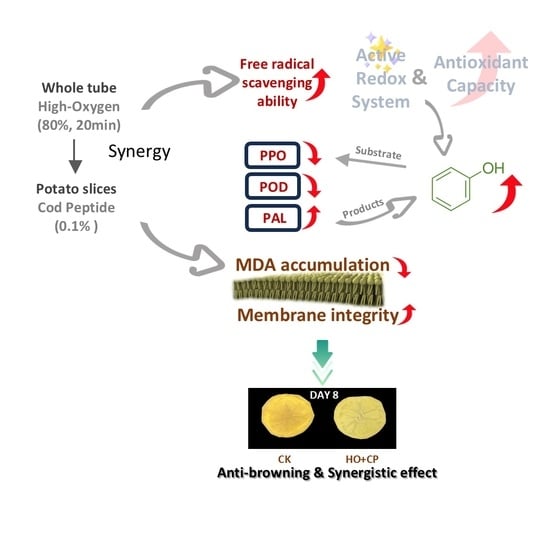
Graphical abstract
Open AccessArticle
Incorporating Fatty Acids Enhanced the Performance of Konjac Glucomannan/Chitosan/Zein Film
by
Xiumei Wang, Yibin Chen, Xiaoxu Zhao and Jie Pang
Foods 2025, 14(9), 1563; https://doi.org/10.3390/foods14091563 - 29 Apr 2025
Abstract
The effects of stearic acid (SA) and lauric acid (LA) with different concentrations on the structure and physicochemical properties of konjac glucomannan (KGM)/chitosan (CTS)/Zein (KCZ) film were systematically investigated in this paper. The rheology results suggested that the apparent viscosity of the KCZ
[...] Read more.
The effects of stearic acid (SA) and lauric acid (LA) with different concentrations on the structure and physicochemical properties of konjac glucomannan (KGM)/chitosan (CTS)/Zein (KCZ) film were systematically investigated in this paper. The rheology results suggested that the apparent viscosity of the KCZ film solution was significantly enhanced after adding fatty acids (FAs), and all the film-forming solutions were typical non-Newtonian pseudoplastic fluids. Hydrogen bond interactions were formed among KGM, CTS, Zein, and FA molecules. KCZ-FA films had higher crystallinities than KCZ film, and their crystallinities increased with the increase in FA concentrations. Microstructure indicated that adding FAs significantly affected the surface morphologies and roughness of KCZ film. KCZ-LA films exhibited much rougher surfaces than KCZ-SA films when FA concentrations were the same. Moreover, the incorporation of FAs significantly (p < 0.05) decreased the transmittance of KCZ film. KCZ-FA films exhibited higher hydrophobicities and water vapor barrier properties than KCZ film due to their significantly (p < 0.05) higher water contact angle, lower water solubility, water content, and vapor permeability values. The thermal stabilities, color attributes, and mechanical properties of KCZ film were also improved after adding appropriate concentrations of FA. Therefore, KCZ-FA films with excellent performances are promising food packaging materials in the future.
Full article
(This article belongs to the Section Food Packaging and Preservation)
Open AccessArticle
Development of Antimicrobial Coatings from Ficus carica Latex for Improving the Quality of Dried Figs
by
Yesuneh Gizaw, Rocío Casquete, María del Carmen Caballero, María de Guía Córdoba and María José Benito
Foods 2025, 14(9), 1562; https://doi.org/10.3390/foods14091562 - 29 Apr 2025
Abstract
To carry out this work, latex from Ficus carica was obtained for the production of coatings, the characteristics of the produced coatings were analyzed, and their application on dried figs was evaluated. Work was conducted to obtain latex and produce coatings, optimizing the
[...] Read more.
To carry out this work, latex from Ficus carica was obtained for the production of coatings, the characteristics of the produced coatings were analyzed, and their application on dried figs was evaluated. Work was conducted to obtain latex and produce coatings, optimizing the mixture and determining its properties. Additionally, the shelf life of coated fruits was studied. The results showed that the coatings had a milky white color, a thickness between 0.04 mm and 0.09 mm, a moisture content close to 25%, and a water solubility ranging from 80% to 98.73%. The 10% latex coatings showed better elasticity and resistance, being selected for the shelf life study. The optimal formulations selected were 28, 29, and 31, all with 10% latex. These coatings exhibited interesting antimicrobial activities against bacteria Escherichia coli, Staphylococcus aureus, and Salmonella choleraesuis and antifungal activity against Botrytis cinerea, Penicillium expansum, Aspergillus flavus, and Monilinia fructicola. When applied to dried figs, it was observed that the appearance of the figs did not visibly change. Antioxidant activity was highest in batch 28, which also showed less microbiology and lower hardness at 60 days. Thus, coatings not only helped maintain the natural color of the fruits but also preserved their freshness and overall quality for a longer period. This makes them an effective and sustainable solution for the food industry.
Full article
(This article belongs to the Section Food Microbiology)
►▼
Show Figures
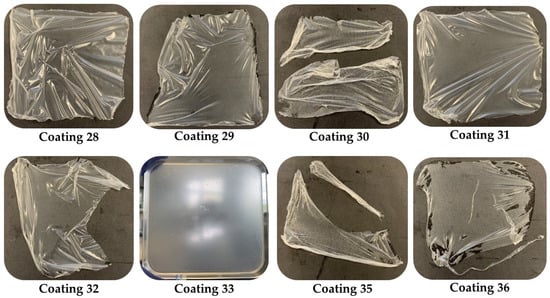
Figure 1
Open AccessArticle
Influence of Autochthonous Lactic Acid Bacteria Cultures on the Microbiota and Biogenic Amine Production in Medium-Ripened Artisan Goat Cheese
by
Julia Mariano Caju de Oliveira, Adriane Elisabete Costa Antunes, Gustavo Felipe Correia Sales, Camila Neves Meireles Costa, Angela Matilde da Silva Alves, Kaíque Yago Gervazio de Lima, Celso José Bruno de Oliveira, Antônio Silvio do Egito, Karina Maria Olbrich dos Santos, Evandro Leite de Souza, Maria Teresa Bertoldo Pacheco and Maria Elieidy Gomes de Oliveira
Foods 2025, 14(9), 1561; https://doi.org/10.3390/foods14091561 - 29 Apr 2025
Abstract
This study evaluated the effects of adding the autochthonous cultures Limosilactobacillus mucosae CNPC007 (LM) and Lactiplantibacillus plantarum CNPC003 (LP), originally isolated from goat milk and goat cheese, respectively, on microbiological safety, microbiota composition (analyzed through 16S rRNA gene metataxonomic sequencing), and biogenic amine (BA) production
[...] Read more.
This study evaluated the effects of adding the autochthonous cultures Limosilactobacillus mucosae CNPC007 (LM) and Lactiplantibacillus plantarum CNPC003 (LP), originally isolated from goat milk and goat cheese, respectively, on microbiological safety, microbiota composition (analyzed through 16S rRNA gene metataxonomic sequencing), and biogenic amine (BA) production in artisanal goat (coalho) cheese made from raw or pasteurized milk during 60 days of ripening at 10 °C. Six types of cheese were produced, varying in milk treatment (raw or pasteurized) and the presence or absence of LP or LM cultures. Adding either LP or LM significantly modulated the microbiota, favoring Streptococcus dominance and reducing overall bacterial diversity compared to non-inoculated cheeses. Raw milk cheeses with added autochthonous cultures exhibited a microbial profile like pasteurized cheeses, suggesting a homogenizing effect on the microbiome. Both cultures effectively reduced microbial load in raw milk cheeses after 20 days, reaching levels comparable to pasteurized cheeses by the end of ripening. Although BA concentrations increased over time, all samples remained within safe limits. Cheeses with LP addition exhibited lower BA levels, suggesting a modulating effect on their biosynthesis. Histamine concentrations were higher in raw milk cheeses with added cultures but remained well below hazardous levels. These findings suggest that incorporating either LP or LM strains is a promising strategy for enhancing the microbial safety and standardization of artisanal goat cheese while preserving its traditional characteristics.
Full article
(This article belongs to the Special Issue Interactions Between Gut Microbiota and Food Bioactive Components: Implications for Health)
►▼
Show Figures
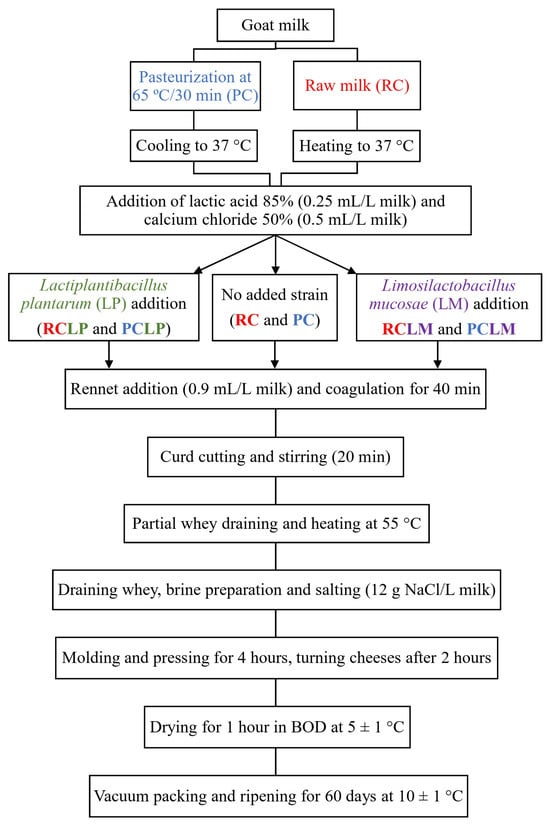
Figure 1
Open AccessArticle
Covalent Grafting of Inorganic Selenium to the Water-Soluble and Nondigestive Chinese Yam Polysaccharides Causes Greater Protection of IEC-6 Cells with Acrylamide Injury
by
Zhen-Xing Wang, Li-Li Zhang and Xin-Huai Zhao
Foods 2025, 14(9), 1560; https://doi.org/10.3390/foods14091560 - 29 Apr 2025
Abstract
Acrylamide, a harmful substance generated during the normal thermal treatment of foods, has been shown to adversely affect human health, particularly the vital intestinal barrier function. Meanwhile, natural polysaccharides are recognized to exert an important biofunction in the intestine by protecting barrier integrity.
[...] Read more.
Acrylamide, a harmful substance generated during the normal thermal treatment of foods, has been shown to adversely affect human health, particularly the vital intestinal barrier function. Meanwhile, natural polysaccharides are recognized to exert an important biofunction in the intestine by protecting barrier integrity. In this study, the non-starch, water-soluble, and nondigestive yam polysaccharide (YP) was extracted from fresh Chinese yam, while two selenylated derivatives with different extents of selenylation were prepared via the HNO3-Na2SeO3 reaction system, and designated as YPSe-I and YPSe-II, respectively. Their protective activities and the associated molecular mechanisms of these substances against acrylamide-induced damage in rat intestinal epithelial (IEC-6) cells were thereby investigated. The experimental results demonstrated that the selenium contents of YPSe-I and YPSe-II were 0.80 and 1.48 g/kg, respectively, whereas that of the original YP was merely 0.04 g/kg. In IEC-6 cells, in comparison with YP, both YPSe-I and YPSe-II showed higher efficacy than YP in alleviating acrylamide-induced cell toxicity through promoting cell viability, suppressing the release of lactate dehydrogenase, and decreasing the generation of intracellular reactive oxygen species. Both YPSe-I and YPSe-II could also manifest higher effectiveness than YP in maintaining cell barrier integrity against the acrylamide-induced barrier disruption. The mentioned barrier protection was achieved by increasing transepithelial electrical resistance, reducing paracellular permeability, facilitating the distribution and expression of F-actin between the cells, and up-regulating the production of three tight junctions, namely ZO-1, occludin, and claudin-1. Additionally, acrylamide was observed to trigger the activation of the MAPK signaling pathway, thereby leading to cell barrier dysfunction. In contrast, YPSe-I and particularly YPSe-II were capable of down-regulating two MAPK-related proteins, namely p-p38 and p-JNK, and thereby inhibiting the acrylamide-induced activation of the MAPK signaling pathway. Moreover, YPSe-II in the cells was consistently shown to provide greater barrier protection than YPSe-I. In conclusion, chemical selenylation of YP could cause higher activity in mitigating acrylamide-induced cytotoxicity and intestinal barrier dysfunction, while the efficacy of activity enhancement was positively affected by the selenylation extent.
Full article
(This article belongs to the Section Food Toxicology)
►▼
Show Figures
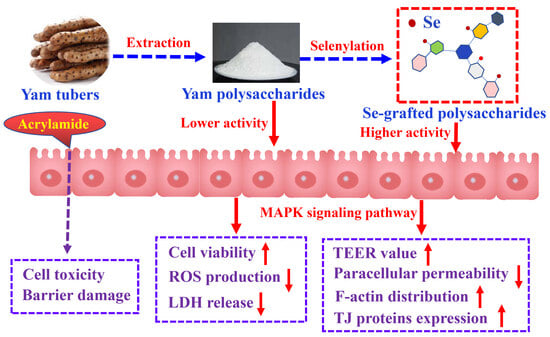
Graphical abstract
Open AccessReview
Could a Mediterranean Diet Modulate Alzheimer’s Disease Progression? The Role of Gut Microbiota and Metabolite Signatures in Neurodegeneration
by
Alice N. Mafe and Dietrich Büsselberg
Foods 2025, 14(9), 1559; https://doi.org/10.3390/foods14091559 - 29 Apr 2025
Abstract
Neurodegenerative disorders such as Alzheimer’s disease (AD), the most common form of dementia, represent a growing global health crisis, yet current treatment strategies remain primarily palliative. Recent studies have shown that neurodegeneration through complex interactions within the gut–brain axis largely depends on the
[...] Read more.
Neurodegenerative disorders such as Alzheimer’s disease (AD), the most common form of dementia, represent a growing global health crisis, yet current treatment strategies remain primarily palliative. Recent studies have shown that neurodegeneration through complex interactions within the gut–brain axis largely depends on the gut microbiota and its metabolites. This review explores the intricate molecular mechanisms linking gut microbiota dysbiosis to cognitive decline, emphasizing the impact of microbial metabolites, including short-chain fatty acids (SCFAs), bile acids, and tryptophan metabolites, on neuroinflammation, blood–brain barrier (BBB) integrity, and amyloid-β and tau pathology. The paper highlights major microbiome signatures associated with Alzheimer’s disease, detailing their metabolic pathways and inflammatory crosstalk. Dietary interventions have shown promise in modulating gut microbiota composition, potentially mitigating neurodegenerative processes. This review critically examines the influence of dietary patterns, such as the Mediterranean and Western diets, on microbiota-mediated neuroprotection. Bioactive compounds like prebiotics, omega-3 fatty acids, and polyphenols exhibit neuroprotective effects by modulating gut microbiota and reducing neuroinflammation. Furthermore, it discusses emerging microbiome-based therapeutic strategies, including probiotics, prebiotics, postbiotics, and fecal microbiota transplantation (FMT), as potential interventions for slowing Alzheimer’s progression. Despite these advances, several knowledge gaps remain, including interindividual variability in microbiome responses to dietary interventions and the need for large-scale, longitudinal studies. The study proposes an integrative, precision medicine approach, incorporating microbiome science into Alzheimer’s treatment paradigms. Ultimately, cognizance of the gut–brain axis at a mechanistic level could unlock novel therapeutic avenues, offering a non-invasive, diet-based strategy for managing neurodegeneration and improving cognitive health.
Full article
(This article belongs to the Special Issue Functional Foods and Their Benefits for Health Regulation)
►▼
Show Figures
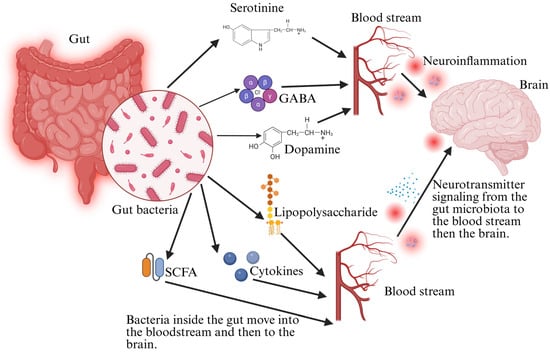
Figure 1
Open AccessArticle
Chemical, Sensory Variations in Black Teas from Six Tea Cultivars in Jingshan, China
by
Rui Wu, Huiling Liang, Nan Hu, Jiajia Lu, Chunfang Li and Desong Tang
Foods 2025, 14(9), 1558; https://doi.org/10.3390/foods14091558 - 29 Apr 2025
Abstract
The development of black tea quality is the outcome of the synergistic interaction between tea cultivars and the ecological environment of the production area, including factors such as climate, soil, and cultivation practices. Nevertheless, within a specific geographical region, systematic analysis of the
[...] Read more.
The development of black tea quality is the outcome of the synergistic interaction between tea cultivars and the ecological environment of the production area, including factors such as climate, soil, and cultivation practices. Nevertheless, within a specific geographical region, systematic analysis of the environmental regulation mechanisms governing processing adaptability and quality formation among different cultivars remains insufficient. This study evaluated six Camellia sinensis cultivars from the Jingshan region of Hangzhou, China, integrating non-targeted metabolomics, sensory profiling, bioassays, and molecular docking to elucidate cultivar-specific quality attributes. Non-volatile metabolomics identified 84 metabolites linked to color and taste, including amino acids, catechins, flavonoid glycosides, and phenolic acids. Sensory and metabolite correlations revealed that amino acids enhanced brightness and imparted fresh-sweet flavors, while catechins contributed to bitterness and astringency. Specific metabolites, such as 4-hydroxybenzoyl glucose and feruloyl quinic acid, modulated color luminance. Volatile analysis identified 13 aroma-active compounds (OAV ≥ 1), with 1-octen-3-ol, phenylacetaldehyde, and linalool endowing JK with distinct floral-fruity notes. Molecular docking further demonstrated interactions between these volatiles and olfactory receptors (e.g., OR1A1 and OR2J2), providing mechanistic insights into aroma perception. These findings establish a robust link between cultivar-driven metabolic profiles in black tea, offering actionable criteria for cultivar selection and quality optimization in regional tea production.
Full article
(This article belongs to the Special Issue State-of-the-Art Review of Tea: Processing Technology, Quality Control and Health Benefits)
►▼
Show Figures

Figure 1
Open AccessArticle
Volvariella volvacea Polypeptide Mitigates Alcohol-Induced Liver Injury: A Multi-Omics Study
by
Bingzhi Chen, Juanqin Chen, Huihua Wu, Fangyi Zhang, Lili Chen, Weibin Zhang, Jing Yang, Li Yuan, Yuji Jiang and Youjin Deng
Foods 2025, 14(9), 1557; https://doi.org/10.3390/foods14091557 - 29 Apr 2025
Abstract
This study investigated the hepatoprotective mechanisms of Volvariella volvacea fruiting body polypeptide (VVFP, 1–3 kDa) against acute alcohol-induced liver injury using multi-omics approaches. Male ICR mice pretreated with VVFP (100–400 mg/kg) showed significantly prolonged alcohol tolerance latency (p < 0.05) and accelerated
[...] Read more.
This study investigated the hepatoprotective mechanisms of Volvariella volvacea fruiting body polypeptide (VVFP, 1–3 kDa) against acute alcohol-induced liver injury using multi-omics approaches. Male ICR mice pretreated with VVFP (100–400 mg/kg) showed significantly prolonged alcohol tolerance latency (p < 0.05) and accelerated sobriety recovery compared to controls. Integrated transcriptomics and metabolomics revealed VVFP’s dual regulatory effects: (1) transcriptional regulation of 36 endoplasmic reticulum stress genes (e.g., ERP57, Derl) through protein processing pathways (KEGG:04141), and (2) metabolic modulation of 23 hepatic metabolites, particularly phosphatidylcholines and organic acids, via amino acid biosynthesis and glycerophospholipid metabolism. Cross-omics analysis identified eight coregulated genes (Got1, Arg2, Srm, etc.) interacting with key metabolites (4-guanidinobutyric acid, GABA) through linoleic acid metabolism. These findings demonstrate VVFP’s therapeutic potential as a functional food ingredient by highlighting its ability to simultaneously target hepatic stress responses and metabolic homeostasis during alcohol detoxification.
Full article
(This article belongs to the Special Issue Bioactive Compounds in Fruits and Vegetables: Processing, Bioavailability and Functional Properties)
►▼
Show Figures
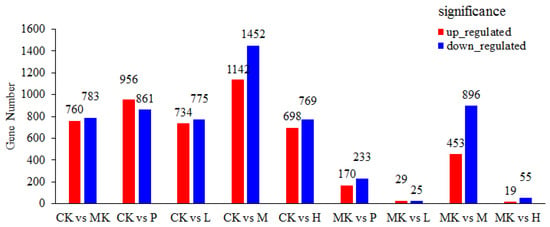
Figure 1
Open AccessArticle
Insight into the Relationship of Spray-Drying Conditions with the Physicochemical and Gelation Properties of Egg White Protein
by
Yuying Hu, Yan Hu, Huiyi Wu, Luyang Bao, Xin Shi, Can Wu, Bing Cui, Hongshan Liang and Bin Zhou
Foods 2025, 14(9), 1556; https://doi.org/10.3390/foods14091556 - 29 Apr 2025
Abstract
This study aimed to provide systematic insight into the relationship between spray conditions and the physicochemical and gelation properties of egg white protein (EWP). Specifically, the effects of two key factors, the inlet temperature and flow rate, on the physicochemical and structural properties
[...] Read more.
This study aimed to provide systematic insight into the relationship between spray conditions and the physicochemical and gelation properties of egg white protein (EWP). Specifically, the effects of two key factors, the inlet temperature and flow rate, on the physicochemical and structural properties of EWP were determined. The analysis revealed that as the spray-drying temperature increased, more hydrophobic groups in EWP were exposed and prone to aggregate. Furthermore, the physicochemical and rheological properties and microstructure of egg white protein gel (EWPG) were determined. The results indicate that under a relatively high inlet temperature and a low flow rate, the hardness, springing, and water-holding capacity of the produced gel were improved. Excessively high temperatures were detrimental to pre-aggregate formation and the development of a homogeneous network. The rheological results demonstrate that the EWPG exhibited a weak frequency dependence and elastic-dominant gel characteristics. Further analysis indicated that the inlet temperature significantly influenced the nonlinear response of the EWPG, with the strongest higher-order viscous nonlinear properties observed at 140 °C. The microstructure suggested that at 140 °C, the EWPG achieved a minimum porosity of 50.07% and a maximum fractal dimension (Df) of 2.745, where a uniform network structure was generated. This study demonstrated that relatively high temperatures and low flow rates in the spray-drying process were advantageous for producing egg white protein gel with desirable characteristics, which has potential for the actual application of egg-based food products.
Full article
(This article belongs to the Special Issue Innovations in Novel Protein Resources and Sustainable Utilization of Traditional Proteins)
►▼
Show Figures
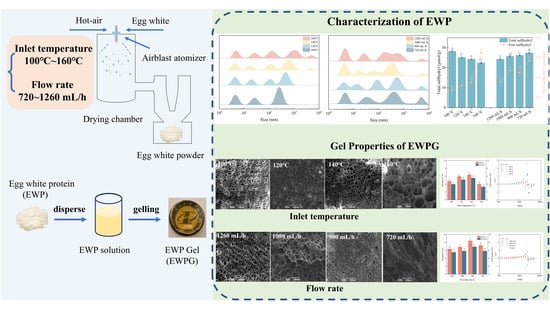
Graphical abstract
Open AccessArticle
Protective Effect of Whey Protein and Polysaccharide Complexes on Lactobacillus paracasei F50: Comparative Analysis of Powder Characteristics and Stability
by
Xinrui Zhang, Xiaowei Peng, Huijing Chen, Aijun Li, Gang Yang and Jianquan Kan
Foods 2025, 14(9), 1555; https://doi.org/10.3390/foods14091555 - 28 Apr 2025
Abstract
To enhance Lactobacillus paracei F50 viability during spray drying and long-term storage, this study evaluates whey protein (WP) crosslinked with four polysaccharides (κ-carrageenan (KC), xanthan gum (XG), low-methoxyl pectin (LMP), sodium alginate (SA)) for the first time as protective matrices for L. paracasei
[...] Read more.
To enhance Lactobacillus paracei F50 viability during spray drying and long-term storage, this study evaluates whey protein (WP) crosslinked with four polysaccharides (κ-carrageenan (KC), xanthan gum (XG), low-methoxyl pectin (LMP), sodium alginate (SA)) for the first time as protective matrices for L. paracasei F50 during spray drying. The four kinds of crosslinked wall materials were compared by various characterization methods. Among them, the WP-κ-carrageenan (WP-KC) composite exhibited optimal performance, forming a uniform microcapsule with high colloidal stability. After spray drying, WP-KC achieved the highest viable cell density (9.62 lg CFU/g) and survival rate (91.85%). Notably, WP-KC maintained viability above 8.68 lg CFU/g after 120 days of storage at 4 °C, surpassing other formulations. Structural analysis showed that the WP-KC microcapsule was completely encapsulated without breaking or leaking and confirmed the molecular interaction between WP and KC. Under the condition of high temperatures (≤142.63 °C), the wall material of the microcapsule does not undergo any endothermic or exothermic process and is in a state of thermodynamic equilibrium, with excellent stability and good dispersion. Additionally, microcapsules exhibited enhanced resistance to thermal stress (55–75 °C) and UV irradiation, higher than that of free cells. These results highlight WP-KC as an industrially viable encapsulation system for improving probiotic stability in functional foods, offering critical insights into polysaccharide–protein interactions for optimized delivery systems.
Full article
(This article belongs to the Section Food Engineering and Technology)
►▼
Show Figures
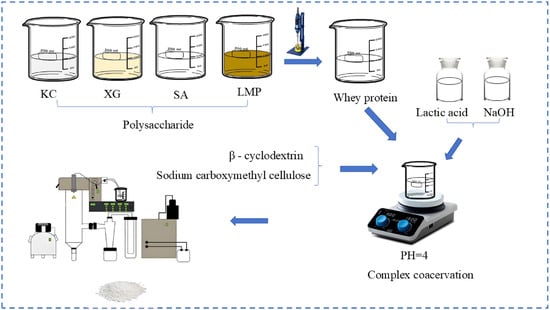
Figure 1

Journal Menu
► ▼ Journal Menu-
- Foods Home
- Aims & Scope
- Editorial Board
- Reviewer Board
- Topical Advisory Panel
- Instructions for Authors
- Special Issues
- Topics
- Sections & Collections
- Article Processing Charge
- Indexing & Archiving
- Editor’s Choice Articles
- Most Cited & Viewed
- Journal Statistics
- Journal History
- Journal Awards
- Society Collaborations
- Conferences
- Editorial Office
Journal Browser
► ▼ Journal BrowserHighly Accessed Articles
Latest Books
E-Mail Alert
News
Topics
Topic in
Analytica, Foods, Molecules, Processes, Separations
New Trends on Separation and Extraction of Bioactive Compounds and Respective Applications
Topic Editors: Isabel Maria Duque Martins, Madalena M. DiasDeadline: 30 April 2025
Topic in
CIMB, Foods, IJMS, Sci. Pharm., Antioxidants, Nutrients
Nutrients, Food Bioactives, and Functional Foods in Gastrointestinal and Metabolic Disorders
Topic Editors: Samuel Fernández-Tomé, Ortega Moreno LorenaDeadline: 31 May 2025
Topic in
Chemistry, Foods, IJMS, Molecules, Separations
Recent Trends and Advances in Food Authentication and Traceability
Topic Editors: Michael Kontominas, Anastasia BadekaDeadline: 30 June 2025
Topic in
Biomolecules, Energies, Foods, IJMS, Polymers
Microbes and Their Products for Sustainable Human Life
Topic Editors: Shashi Kant Bhatia, Ranjit GuravDeadline: 7 July 2025

Conferences
Special Issues
Special Issue in
Foods
Exploring the Effect of Different Processing Methods on In Vitro Digestibility of Food Proteins
Guest Editors: Huijuan Zhang, Feiyue RenDeadline: 30 April 2025
Special Issue in
Foods
Natural Bioactive Components to Improve the Nutritional and Health-Related Properties of Food Products
Guest Editors: Wuyang Huang, Daniela Herrera-BalandranoDeadline: 30 April 2025
Special Issue in
Foods
Advances in Improvement and Fortification of Cereal Food
Guest Editors: Stanisław Kowalski, Dorota Gumul, Anna MikulecDeadline: 30 April 2025
Special Issue in
Foods
Concepts, Mechanisms, and Applications of Antioxidants in Food
Guest Editors: João Guilherme Costa, Bojana VidovićDeadline: 30 April 2025
Topical Collections
Topical Collection in
Foods
Edible Films and Coatings for Food Preservation
Collection Editor: Hiléia Karla Silva Souza
Topical Collection in
Foods
Milk and Dairy Products: Chemistry, Structure, Processing and Properties
Collection Editor: Débora Parra Baptista
Topical Collection in
Foods
Phytonutrients in Food: From Traditional to Rational Usage
Collection Editor: Quanhong Li









